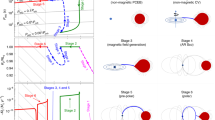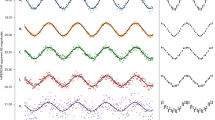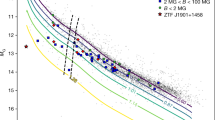Abstract
THE peculiar difficulty pointed out by Eddington regarding the ultimate fate of a white dwarf star led Fowler1 to make the first application of Fermi-Dirac statistics to astrophysics in a fundamental paper which initiated a long series of investigations, particularly by Milne2, in recent years. The starting point is the expression which represents (neglecting the effect of relativistic mechanics) the number of wave functions corresponding to eigen-values lying in the energy-range ɛ to ɛ + dt for a free electron confined in a field-free region of volume V; this is assumed to hold for the stellar interiors though gravitational and electrical fields are present. For degenerate matter equation (1) leads to the well-known expression for the pressure which reduces the equation for mechanical equilibrium for a star to Emden's equation of index 3/2 giving the relation (“Emden-solution”) between the radius R and the mass M of a white dwarf. Lo is a length characteristic of the white dwarf theory where ⊙ is the solar mass, m the mass of the electron, mH the mass of the proton, G the gravitational constant, and ωo3/2 = 132·4 is a number defining the Emden-solution of index 3/2. μ is the mean molecular weight per free electron, μ = 1 for ionized hydrogen and μ = A/Z? 2 for any other completely ionized element of atomic weight A and atomic number Z. (The material in the interior of a white dwarf star is completely ionized due to pressure ionization.)
This is a preview of subscription content, access via your institution
Access options
Subscribe to this journal
Receive 51 print issues and online access
$199.00 per year
only $3.90 per issue
Buy this article
- Purchase on Springer Link
- Instant access to full article PDF
Prices may be subject to local taxes which are calculated during checkout
Similar content being viewed by others
References
Fowler, Mon. Not. Roy. Astro. Soc., 87, 114 (1926).
Milne, Mon. Not. Roy. Astro. Soc., 92, 610 (1932).
Eddington, Mon. Not. Roy. Astro. Soc., 99, 595 (1939).
Wildhack, Phys. Rev., 57, 81 (1940).
Marshak and Bethe, Phys. Rev., 57, 69 (1940).
Rosseland, Mon. Not. Roy. Astro. Soc., 84, 720 (1924).
Kothari, Mon. Not. Roy. Astro. Soc., 96, 833 (1936).
Author information
Authors and Affiliations
Rights and permissions
About this article
Cite this article
KOTHAKT, D. Mass-Radius Relation for a White Dwarf Star. Nature 146, 24–25 (1940). https://doi.org/10.1038/146024b0
Issue Date:
DOI: https://doi.org/10.1038/146024b0
Comments
By submitting a comment you agree to abide by our Terms and Community Guidelines. If you find something abusive or that does not comply with our terms or guidelines please flag it as inappropriate.



